Guidance and examples for Buying Guides relevant for other sectors too
‘Buying Guide’ or 'Buyer's Guide' content are a common SEO tactic particularly amongst retailer ecommerce sites, but they can be used in other types of site too such as financial services. They're popular since they tick many of the boxes for effective on page SEO. They're naturally rich in keywords, dense in character count and recognisably original, it’s an easy target to hit on your SEO checklist. They also enable you to link to your main target category and popular product pages with relevant anchor text, so boosting their effectiveness.
Potential customers also love Buying Guides, since, done well, they’re a great research resource in the early ‘information gathering’ stages of the purchasing decision process.
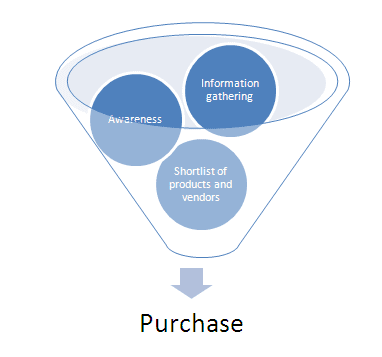
If they provide great advice and a good experience in navigating them, then it’s a great advantage over your competitors if your guides can be read by potential customers early on when they’re thinking of making an important purchase. They're really also a merchandising tool since they enable you to feature best-selling products or brands.
It helps your brand become embedded in the customer’s mind as trusted authority, so later on, when they’re ready to buy, you’re already on the shortlist of vendors.
Examples of buyers' guides
To illustrate the best practices in this post we have taken 3 examples of buyers guides which rank in the top 5 for "buyers guide" + category.
1. John Lewis Fridge Buying guide
Best practice features this page illustrates are:
- <h1> targeting keyword, <h2> simplified for usability
- <h3> are links for subcategories which will help those rank
- Inline link with anchor text "fridge" linking through to product page
- Use of Javascript accordions to make the depth of content easier to navigate
- Links to other forms of advice - their "inspiration guides"
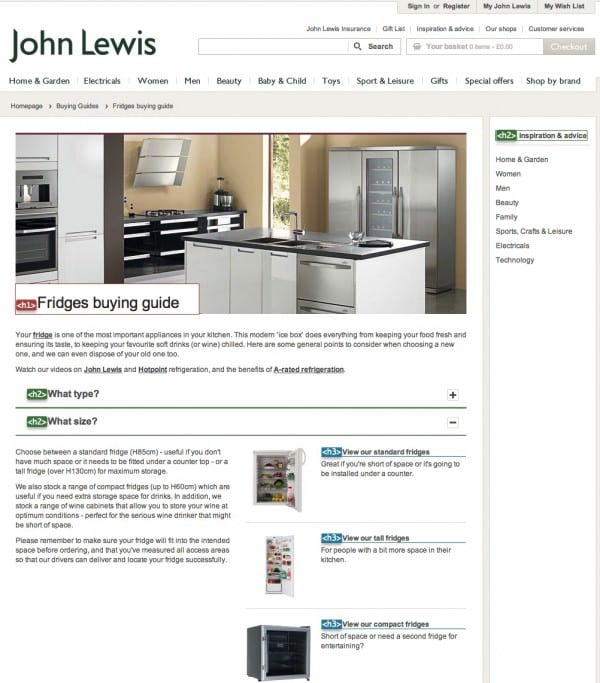
2. Currys camera and camcorder buying guide
Best practice features this page illustrates are:
- A large volume of text isn't necessary to rank well
- Sub-categories are linked to through tabs and table headings giving internal links with relevant anchor text
- Buying guides integrated into main category page on "digital cameras"
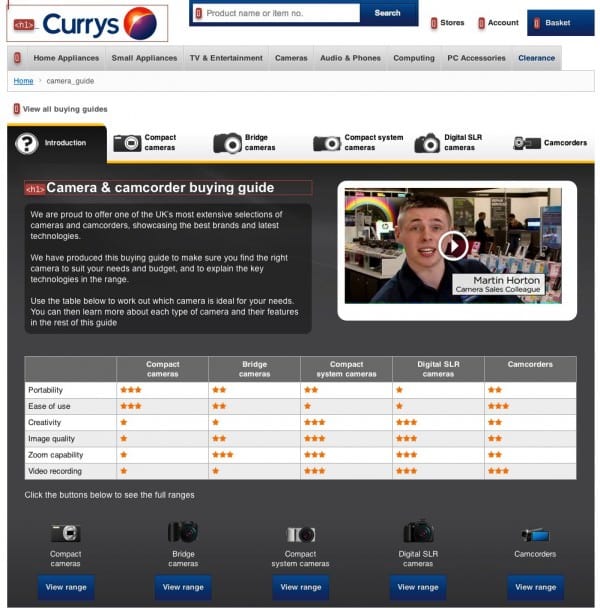
3. Euroffice Buyers Guide page
Best practice features this page illustrates are simply to have a page for collecting buyers guides together with relevant links through to each buyers guides. Each guide is linked to other buying guides and each sub-guide has its own page creating many additional text pages featuring products.
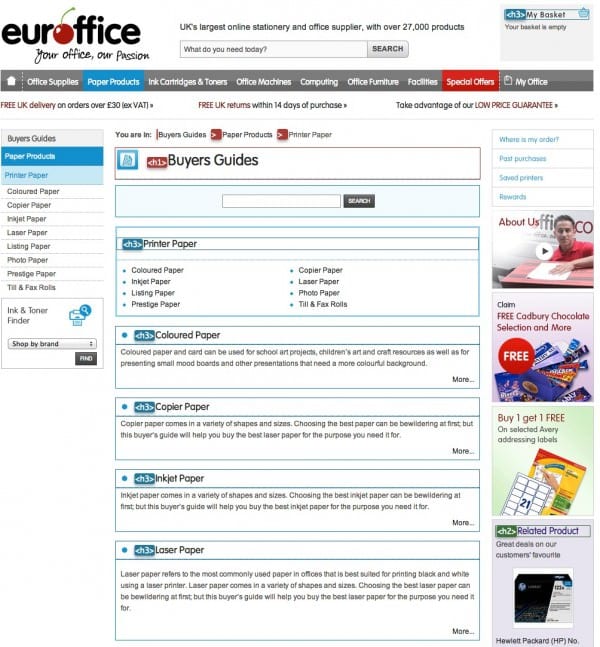
Purchasing Decision Process
Target audience
You may be writing for existing customers who have come back to your site. They may also be completely new customers who have arrived at the site through a search engine query. What they have in common is that they are searching for information?
Assume the customer knows nothing. What would you tell a friend when they were just starting think about making a considered purchase?
Aim of Buying Guides
The aim of Buying Guides is to be an essential ‘How To’ guide so that the customer can make informed choices.
Typical information may include:
- Key A/B decisions to be made early in the decision-making process (e.g. for cars it could be manual or automatic, for suitcases it could be hard-shelled or soft-sided)
- Main generic characteristics of this product category (e.g for electric toothbrushes, it could be oscillating rotary brushes and sonic vibrating brushes)
- Features to look for. (Explaining the benefits, and demonstrate why some are worth paying more for, such as superior benefits, more complex manufacturing).
- Functional choices v personal choices (e.g. make it clear when there is a reason to choose one type of product over another and when it is simply down to a matter of personal preference.)
Additional SEO best practice ideas
- To target certain keywords, these should be included in headings and sub-heads as these are given more weight by search engines.
- Where possible, include links inserted to other web pages on the site – either generic categories or specific products.
- It’s not a good idea to link to off-site web pages, as this encourages the reader to leave your site. A typical example might be a link to a national database of recycling centres for electrical waste on a Buying Guide for washing machines. This may be helpful for the customer, but resist the temptation. [Editor's note - I would argue this can be a good practice since it increases the authority of the page and in reality the leakage is low and you can improve perception of the brand]
Tone of Voice
It is vital that the Buying Guide appears to be impartial and neutral, so that it is a trusted source of information.
For this reason the tone of voice may be less chatty and more passive than selling copy on other parts of the website.
You should avoid any exhortations to buy. For example, instead of phrases like ‘Enjoy a blissful night’s sleep’, say ‘Many people find that an orthopedic pillow helps them sleep better and wake more refreshed’.
The tone should be:
- Authoritative
- Unbiased
- Helpful and friendly, but not overly chatty
- Concise yet comprehensive
- Interesting – you want them to read to the end!
It is also helpful to incorporate bullet point lists, diagrams, tables and infographics where appropriate
Structure
Remember that the aim of the Buying Guide is to provide informed, useful advice which positions your brand as a helpful expert and trusted vendor.
To achieve this, a successful Buying Guide presents options to the customer as a funnel, starting with the main decisions which influence the purchase, exploring the options within each main options.
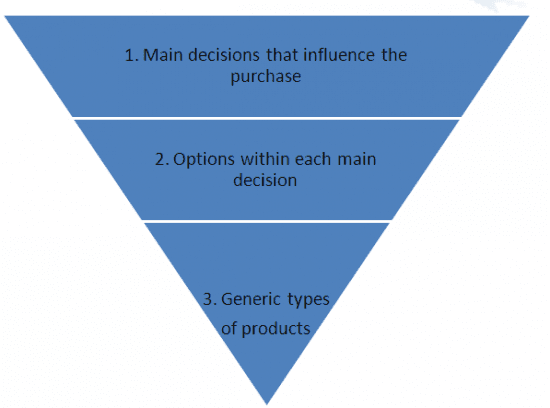
Buying Guide Funnel
Parameters
Buying Guides are not expected to be updated regularly, so care should be taken to write them in such a way that they are ‘evergreen’. Therefore avoid talking about specific products where possible, instead focusing on generic types of products and key features to look out for.
Whilst your Buying Guide should be impartial, it is, of course, sensible to structure the content and slant the information towards the products you actually sell.
The focus should be on selling the expertise of your brand, and encourage the reader to click-through to the products. Do not try and hard sell a particular product within the Buying Guide.
By being a truly impartial and valuable source of information, the Buying Guide is a great way to build a trusted relationship with the brand and encourage a few more search engine spiders to come and sup at your site.
Do you have any other tips or examples to add.











